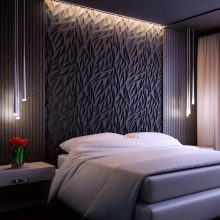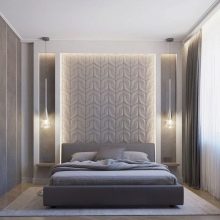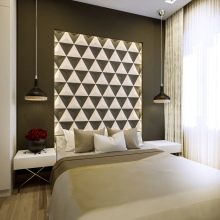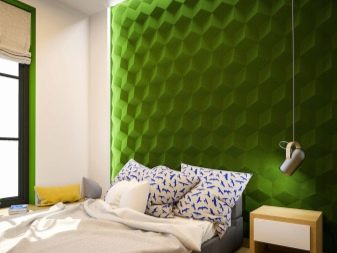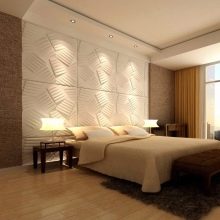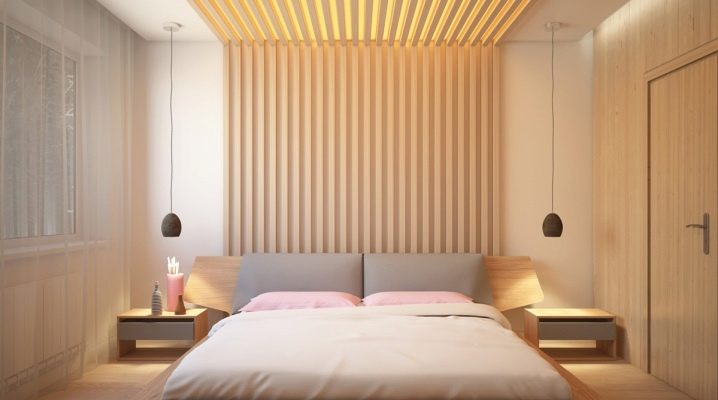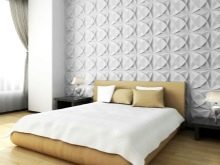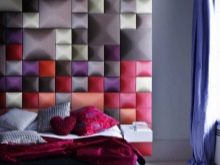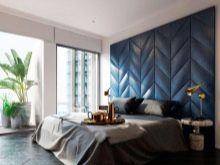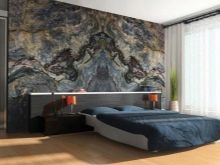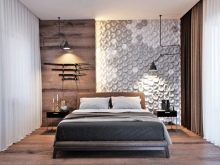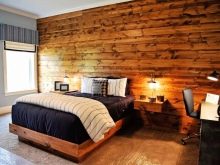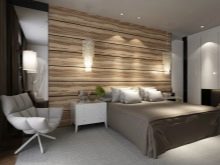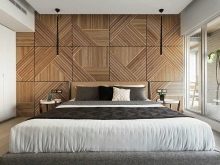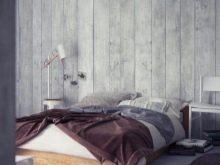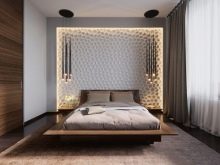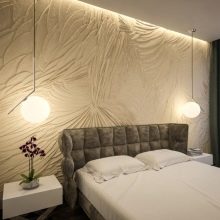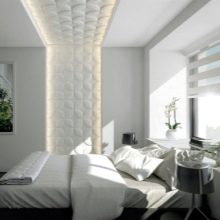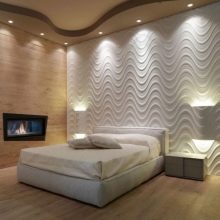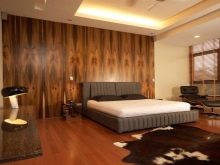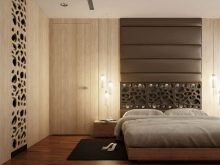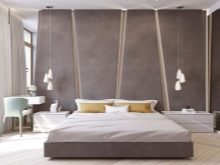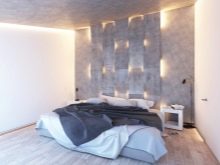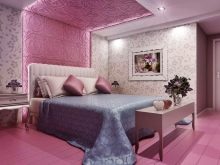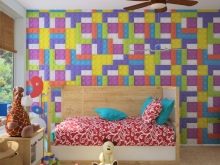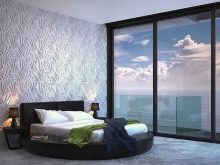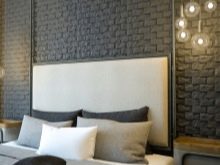All About Bedroom Wall Panels
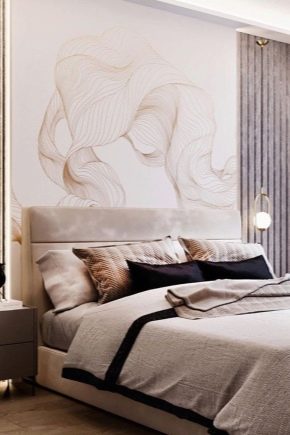
Knowing everything about wall panels for a bedroom is necessary for those who decide to find an option for a pleasant home arrangement. It is quite possible to use decorative panels on the wall instead of wallpaper in a modern and other style. But to do this, first you need to figure out what the wood panels above the bed and MDF products are, how to choose them and how they might look in practice.
Advantages and disadvantages
The idea of using wall panels for the bedroom instead of wallpaper attracts with the fact that it is an unusual solution, which, as many believe, allows you to get away from the traditional look of wallpaper-covered walls. And expectations are largely justified - the decorative appearance of the panels is significantly different, it is much more flexible than even the same wallpaper. Fastening structures is also not difficult, and for this, wet work is not necessary or minimally necessary. If the walls have any defects, they will quickly be blocked, and the surface will take on an emphatically expensive look.
There is no need for any specialized tool. And those tools that are needed are already in any home, or they can be bought at the nearest store with a suitable profile. Ease of removal and return to place without loss of quality is another major advantage of panel products. With wallpaper, even the best, this cannot be done. What is also important, the alignment of the walls under them is required in exceptional cases, when it is impossible to do without it at all, when the surfaces are extremely skewed.
The cavity separating the panels from the wall is also an advantage. The air gap has a good thermal insulation effect. And in the same cavity it is convenient to stretch electric wires and cables of communication lines, small tubes of various communications. Sound insulation will also be clearly better than wallpaper. Other advantages are as follows:
-
increased hygiene;
-
ease of care;
-
reliability;
-
strength;
-
long time of operation;
-
availability in the delivery of skirting boards and other additional components.
Disadvantages:
-
a noticeable reduction in the area of \ u200b \ u200bthe premises;
-
the need for the installation of supporting structures;
-
the high cost of some natural varieties, primarily from stone and elite varieties of wood;
-
exposure of part of the panels to moisture.
Species overview
Reiki
Such decorative and finishing elements resemble externally long stripes. Their width varies from 1.25 to 3 cm.The thickness is at least 0.8, and the maximum is 1 cm.The length of the structure reaches 240-370 cm.
It is advisable to use slatted products for interior decoration in rooms with a complex structure and contradictory design.
Also, slats are well perceived in small rooms. Stacked planks are often recommended to be installed in the hallway, which allows you to achieve a luxurious appearance. In children's and on closed verandas, they will also be a good decoration element. To fasten structures, wall and corner joints are required, which are recommended by the manufacturers themselves. When laying horizontally, it becomes possible to “play” with textures to taste, but creating a slatted decor on large surfaces is time consuming and laborious.
Hard and soft boards
If you need to decorate not only the area above the bed, but also larger areas, you should pay attention to the slab structures, including the 3D panels that demonstrate an interesting design effect. Along with solid wood products, it is also shown by structures made of softer materials. In any case, the constituent parts of the composition must ensure visual similarity. Soft upholstery on the walls has been used for a very long time, and now they are generally returning to fashion.
They turn out to be more profitable than strong structures in apartment buildings with poor sound insulation. The outer surface is highly decorative, and it will not be difficult to choose the optimal appearance for yourself. It is worth noting that the basic base is still predominantly formed from rigid materials. But there is also a completely flexible cladding, suitable even for many curved surfaces. The outer shell can be formed:
-
from leatherette;
-
natural leather;
-
dense textile fabrics (all of these materials are treated in a special way to impart hydrophobic properties and UV resistance).
Sheets
We are talking about structures with a multi-layer structure, the dimensions of which can reach 2.5 m. Outwardly, they reproduce the appearance of wood, tiles, stone and other natural coatings. It is convenient to finish the largest surfaces with such material. Sheet panels are usually glued. This allows you to abandon the lathing, however, it is required that the surface is as smooth as possible.
Materials (edit)
At least a very long history of their use testifies in favor of wood panels. It has been established that the Egyptian pharaohs already loved this decoration. In other countries of the world, where there were no problems with forests, it was also used separately. At one time it seemed that wood panels would be unambiguously replaced by more modern finishing solutions. However, now they are returning to the podium again and occupy an ever larger share of the market.
Wood finishing:
-
fits harmoniously into a variety of styles (except ultra-modern);
-
utilitarian;
-
allows you to perfectly zone the space;
-
significantly improves the operational characteristics of houses and apartments.
Natural solid wood constructions are in great demand. They are expensive, but they create an impressive and solid look. Since there is usually no high humidity in the bedroom, they can be placed there without any fear.
It is more profitable to use models based on particle board, you just need to be interested in the class of toxin emission. Alternatively, consider:
-
Fiberboard;
-
rattan;
-
bamboo.
Front finishing can be performed by:
-
veneering;
-
applying a laminating film;
-
varnishes;
-
waxes;
-
by embossing;
-
applying gilding;
-
the formation of a geometric relief.
Mirror panels are also used quite often. They create a pleasant decoration effect and visually expand the walls. The purchase costs are relatively low. Thanks to their flexibility, the panels fit easily even on curved surfaces. The interior becomes fresher and more interesting.
Cast and extruded glass:
-
endure blows steadily;
-
perfectly survive hydration;
-
tolerate heat;
-
tolerate ultraviolet light;
-
can replace mirrors.
Plaster wall panels look luxurious and immediately individualize the room. The room will accentuate the owner's solid status. Gypsum is known to be non-toxic, and even if it heats up, there will be no harmful substances. Moreover, gypsum elements fully comply with fire protection standards. Finally, they have excellent thermal insulation and soundproofing properties.
You can also decorate the bedroom with MDF. It has excellent performance parameters. Quality boards (with an official certificate) are made from natural and non-hazardous substances. The increased density (in comparison with chipboard) greatly facilitates the fastening of various objects. Solid resistance to water allows you to actively wash surfaces; it is worth considering, however, that MDF can burn.
MDF:
-
affordable;
-
looks attractive;
-
keeps heat and extraneous sounds;
-
mounted quite easily.
Selection Tips
When choosing panels for a bedroom on the wall, it is necessary to assess, first of all, compliance with sanitary and fire standards. This information is provided on labels and accompanying documents. Fastening using glue or lathing is chosen at your discretion. The second option is much more preferable and reliable. In dry and warm rooms, such as bedrooms, the crate must be formed from wood.
The design of the panels, as well as their price, play an important role. If an attractive antique room is being designed, plaster products are preferred. Rooms in a modern style should look minimalist. Pronounced relief and chic decorations, flashy colors will be contraindicated. However, in many ways, such a composition is individual, and you need to select it to suit your needs, coordinating with other surfaces.
Recommendations for other styles are as follows:
-
in the avant-garde design - visual contrasts to highlight areas;
-
in Art Deco, it is better to use mirror or at least glossy panels, also with contrasts;
-
a vintage atmosphere can be created at the expense of the most common types of wood (elite varieties are not particularly needed);
-
Danish style assumes soft and muted colors;
-
for a bionic setting, a fresh color palette and zoning with walls are preferable;
-
modern is good friends with floral patterns, with curly lines;
-
the atmosphere of Provence is perfectly formed with the help of caramel and milk, lavender and honey flowers;
-
The Russian style is logically connected with carved ornaments, with the richness of textures of carefully selected wood.
Examples in the interior
- The photo shows a gypsum wall panel with a plant theme. It goes well with open space.
- In a more classical setting, however, soft panels with a "square" pattern are much more appropriate.
- But you can also use panels that imitate gray brick masonry. The original texture combined with the same atypical lighting will definitely delight people.
